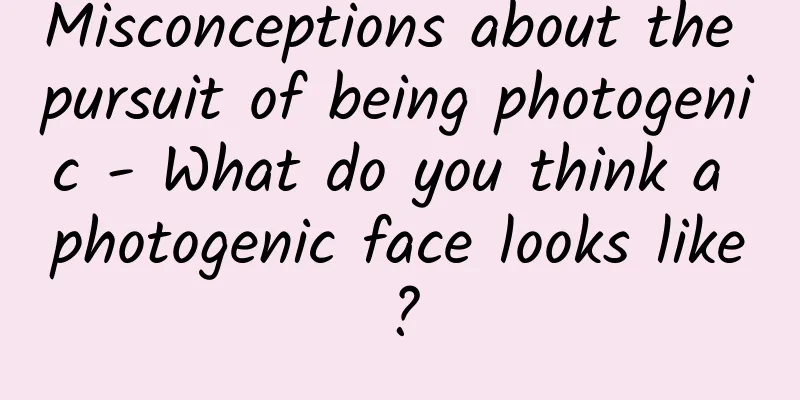Misconceptions about the pursuit of being photogenic - What do you think a photogenic face looks like?

|
Leviathan Press: I looked at the photo of Salm-Hoogstraten carefully. I think his face is somewhat similar to Marcel Duchamp. Of course, the so-called "photogenic" is also closely related to the aesthetics of the times. As for whether Salm-Hoogstraten is photogenic, it depends on personal opinion. I agree with the point of view in the article, that is, one of the main factors for people who are so-called photogenic is that they have accumulated a lot of shooting experience. He/she knows how to show his/her best side. In other words, photogenicness is the result of being selected from a large number of photos. In 1925, a completely new and welcome way of describing human beings was invented. News reports hailed a new Hollywood star: Austrian aristocrat and tennis champion Count Ludwig von Salm-Hoogstraeten, who was rumored to appear in a film from superproducer Samuel Goldwyn. Ludwig von Salm-Hughstraten (1885-1944). © Wikipedia What made the 39-year-old athlete a star? "He's photogenic," Goldwyn told reporters. Soon, newspapers were praising producers for coining a new word. As it turned out, von Salm-Hogstraten’s acting career didn’t take off, but Goldwyn’s word did. Nearly a century later, “photogenic” has become a staple of the selfie age. It’s widely accepted that a photogenic person looks good in photographs. On social media, photogenicity has become a currency: it’s the invisible @ factor for a large number of followers. Hence, there are articles now promising to uncover the secrets of photogenicity[1]; people on TikTok will randomly take stills from their videos to determine whether they are photogenic or not. For most of us, this concept can probably be used to justify our aversion to selfies (we’re not ugly; we’re just not photogenic). However, a closer look reveals little direct evidence that some people are naturally better in front of the camera. Instead, perhaps when someone is called "photogenic," what people are really referring to is the ease that comes from repeated practice in front of the camera, and the ability of the photographer and the camera to capture that feeling. © Business Insider/Bonnie RZM In this sense, photogenicity is more a matter of nurture than nature, and may be less a measure of how attractive someone looks than how well they are attuned to the peculiarities and limitations of modern technology. To understand this, let’s break down some of the common assumptions that underpin photogenicity. First up: There’s no universal consensus on who’s photogenic and who’s not. “It’s surprising how much we disagree about who we find attractive in photos,” Clare Sutherland, a psychology lecturer at the University of Aberdeen in Scotland, told me. Psychological research, including that of Sutherland, has shown[2] that a person who is rated as very attractive in one photo may be considered less attractive in another. “There are large individual differences in how we judge whether someone looks photogenic or not,” Sutherland said. This also applies to ourselves. In a 2017 study[3], Sutherland and researchers found that, given a set of 12 photos of their own faces, participants generally preferred photos that were completely different from those preferred by their peers. © Luminar Neo The differences in how we perceive our appearance in photos was also the subject of a 2014 study conducted in Japan. In this study [4], researchers took photos of each participant and then slightly altered them, increasing or decreasing the size of the eyes and mouth. The participants were then given four photos of the same face and asked to choose which one had not been altered. Ultimately, people have a harder time recognizing their own real faces than their peers. In other words, it’s hard for us to judge how we appear to others. So when we insist that we are not photogenic, we may not know what we are talking about. Research from Japan suggests that a person who claims to be unphotogenic may be unfamiliar with how they look in front of a camera. This theory is interesting, but it doesn't take into account that being photogenic may actually be a photographic skill. Photogenic people may have mastered their relationship with image-capturing devices. © GIPHY Models all stressed the importance of angles, and there’s some truth to the idea that how we angle our faces can affect the final shot. For example, a photo taken from above can make us look thinner, while a photo taken from the front might make us appear wider. Sometimes this happens unconsciously: since the 1970s, many studies have found[5] that we tend to show the left side of our face when taking photos. © Happy Families Alessandro Soranzo, a psychology researcher at the UK's Sheffield Hallam University, suspects it may have something to do with brain chemistry. “The right hemisphere of our brains is more involved in emotion processing,” Soranzo told me. Since the right hemisphere controls the left side of the face, “our left face is more expressive in terms of emotion.” Whether this actually makes the left side of our face look better is still a matter of debate, Soranzo said. Another factor that complicates being photogenic is the historical bias inherent in photographic technology. In the 20th century, Kodak calibrated the lighting and color of its photographs based on a photograph of a white woman named Shirley.[6] Subsequently, black and brown people found that their skin tones were not accurately represented. For decades, Kodak's "Shirley Cards" were calibrated only on white models. © Kodak While researching early references to photogenicity in newspaper archives, I encountered a number of articles that explicitly acknowledged this bias, including a 1934 article in the Illustrated Daily News that declared that the camera was “kindest to blondes” because they had a “photogenic color.”[7] Sarah Lewis, professor of African American studies at Harvard University and founder of the Vision and Justice Initiative, points out that when you understand the history of the concept, you understand how fluid and unstable the concept of being photogenic itself is. Photography is not a level playing field today either, and as Lewis writes, bias against black people still exists in many of today's digital photographs. For example, cameras that add artificial light or optimize exposure are particularly prone to altering the skin tone of black people. Therefore, using different types of light based on your skin tone is essential to creating a photogenic effect. © Giphy The final factor that makes a person look photogenic is the person taking the photo. Naima Green, an artist and commercial photographer who often works with non-professional models, told me that she encounters many subjects who are nervous in front of the camera. “They are very camera-savvy, so they want to make sure everything they do for me is correct,” she said. “When you are more present in the moment, I think it really changes what’s happening in the picture. ” Rather than contorting people into rigid poses, Green prioritizes making them feel comfortable around her. The trick is to find a sitting or standing position that allows the model's body to relax. It's a small adjustment, but a telling one. We can all do this for ourselves, even when posing for a selfie. The truth is, the people who are often considered the most photogenic may also be those who are repeatedly exposed to photos of themselves, like models or actors. Sure, they may be considered more attractive in traditional terms, and they may be good performers who are good at working with the camera. But perhaps their biggest advantage is simply that they have accumulated a lot of experience. As a result, they are familiar with the camera's features and are able to feel comfortable in front of it. Perhaps those of us who don’t pose professionally just need to remember that being photogenic is probably a skill you can improve with work, just like any other skill. If we wanted, maybe we could take lots of pictures of ourselves so we know our faces from all angles. We could learn the lighting that works for our skin tones, or the poses that make us feel most like ourselves. At some point, we might stop being surprised by what we see in our photos. References: [1]www.glamour.com/story/secrets-of-really-photogenic-p [2]www.pnas.org/doi/10.1073/pnas.1920131117 [3]cognitiveresearchjournal.springeropen.com/articles/10.1186/s41235-017-0058-3 [4]pubmed.ncbi.nlm.nih.gov/25469224/ [5]theconversation.com/selfie-culture-what-your-choice-of-camera-angle-says-about-you-157449 [6]www.npr.org/2014/11/13/363517842/for-decades-kodak-s-shirley-cards-set-photography-s-skin-tone-standard [7]www.newspapers.com/image/689025152 By Michael Waters Translated by tamiya2 Proofreading/Rabbit's Light Footsteps Original article/www.theatlantic.com/family/archive/2023/10/how-to-be-photogenic/675705/ This article is based on the Creative Commons License (BY-NC) and is published by tamiya2 on Leviathan The article only reflects the author's views and does not necessarily represent the position of Leviathan |
<<: How can we get a reliable cancer screening that can cost thousands of dollars?
>>: "Healthy through eating" series | Is instant noodles "junk food"? Four misunderstandings to know
Recommend
China Automobile Dealers Association: Automobile consumption index in December 2020 was 78.9
On January 4, 2020, the China Automobile Dealers ...
Is it enough to summarize the iPhone foreign media reviews as “the best ever”?
Apple's public relations policy has become mu...
Online event promotion planning and solution analysis
For operators, event operation is a very importan...
How to maximize the effectiveness of video, information flow and other platforms?
Today’s article is about: Marketing strategies fo...
One third of the liver was "eaten", and the murderer was actually a "fish"?
According to Guilin Evening News, Ms. Feng from Q...
Redefining B2D 0HI.CN will be launched on 36kr crowdfunding platform
We are not unfamiliar with developer service plat...
Why do I see strange patterns when I rub my eyes?
Long working or studying time People's eyes a...
Maximizing IP value from the acquisition of the copyright of the popular comic "Dragon Sakura" by Alibaba
There have been rumors of Alibaba's involveme...
9 examples of obtaining seed users
I often joke with my friends: Young people, don’t...
How did Bilibili produce tens of millions of up-masters?
If you are a person who likes niche cultural circ...
What the hell is the "Internet of Things" (64PPT)
Nowadays, the Internet and mobile Internet have b...
"Tao Yuanming" Carnival - In-depth look at the key indicators of the brand sponsors of "Produce 101"
"Produce 101" has become popular, and i...
2020 Short Video E-commerce Live Streaming Operation Plan Practical Tips
A quality live broadcast must be carefully planne...
How to get more likes on Tik Tok short videos?
Tik Tok is a short video sharing platform that he...
How much does it cost to develop a supplement mini program in Meishan?
How much does it cost to be an agent for a supple...









